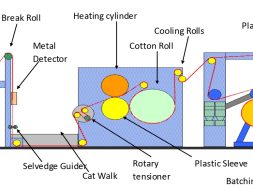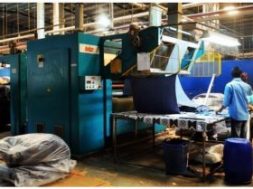Determination of Lea strength & C.S.P. of Cotton
Determination of Lea strength & C.S.P. of Cotton.
Introduction:
The strength of a yarn gives us an idea how much load we can apply on it and it is very important for different process of yarn. On the other hand C.S.P of yarn indicates how good or bad the yarn is.
Objects :
- To find out the strength and C.S.P of yarn.
- To assume about the quality of yarn.
Theory:
C.S.P is the product of English count and strength of yarn in pound. i.e. C.S.P = Strength of yarn in pound x Count in English system.
Again, English count is the no. of hanks in 840 yards length per 1 pound weight of yarn. i.e.
- L = length of the sample &
- l = unit length of the system
- W = wt. Of the sample &
- w = unit wt. of the system.
A lea strength tester measures the strength of one lea yarn. One lea means 120 yards. Strength is a measure of the steady force necessary to break a material and is measured in pound. The m/c works in constant rate of extension. Assuming the specimen to be extensible and an absence of any dynamic effects, we get from the figure:
Fr = Mgr = MgRsinθ
As the value of MgR and r are constant, therefore
F ∞ sinθ.
According to the applied force the m/c dial gives us the strength in lb on the basis of this θ.

Figure: The pendulum lever principle
Apparatus :
- Cotton yarn
- Wrap reel
- Lea strength tester
- Electrical balance
M/c Specification:
- The Lea Strength Tester, Good Brand & Co. Ltd.
- Capacity: 100lb
Atmospheric condition:
- Wet condition: – 26 ° c. & Dry condition: – 30° c.
- Difference between wet and dry bulb = 30° c-26 ° c. = 4° c
- So, relative humidity (RH) = 70 %
Sample:
One lea cotton yarn (1 lea =120 yards).
Working procedure:
At first one lea cotton yarn is measured by wrap reel and in this way 10 samples are taken for testing. Now, the first sample is fixed with the upper jaw J1 and the lower jaw J2. The m/c is started and observed the dial until the sample is turn out. When the sample is torn out the m/c is stopped and the reading is taken. By this way the others’ reading are taken. Then all the samples are weighted and counts are calculated. C.S.P of the all samples is calculated. This process was repeated for 10 times. At last average and CV% are calculated.
Data:



Result:
- The strength of cotton yarn is 5 lbs & C.V. % is 2.08 %.
- The C.S.P of cotton yarn is 16 & C.V. % is 4.16 %.
- The Count of cotton yarn is 38 & C.V. % is 55%.
Remark: It is considered that fibres having C.S.P less than 1800 are bad or weak, between 1800-2200 are average and greater than 2200 are strong. From our experiment we see that our samples’ average C.S.P is 2397.16 which are greater than the standard 2200 and CV% is 4.16. This is proved that there are many variations in this range but our supplied yarn has good strength. So finally we can say that these yarns have good strength fibres. But it may be vary because our testing atmosphere is not standard.
Conclusion: I would like to thank our respected teacher for the important instructions. I am also grateful to our lab assistants for their kind help. This experiment helps me to know about fibres’ strength and C.S.P which are very important for fiber’s tensile testing. I think this will be very helpful in my future life.
(956)






